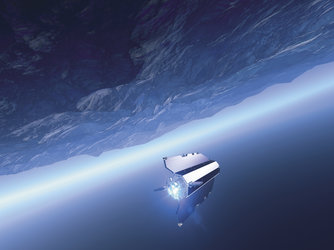Accept all cookies Accept only essential cookies See our Cookie Notice

About ESA
The European Space Agency (ESA) is Europe’s gateway to space. Its mission is to shape the development of Europe’s space capability and ensure that investment in space continues to deliver benefits to the citizens of Europe and the world.
Highlights
ESA - United space in Europe
This is ESA ESA facts Member States & Cooperating States Funding Director General Top management For Member State Delegations European vision European Space Policy ESA & EU Responsibility & Sustainability Annual Report Calendar of meetings Corporate newsEstablishments & sites
ESA Headquarters ESA ESTEC ESA ESOC ESA ESRIN ESA EAC ESA ESAC Europe's Spaceport ESA ESEC ESA ECSAT Brussels Office Washington OfficeWorking with ESA
Business with ESA ESA Commercialisation Gateway Law at ESA Careers Cyber resilience at ESA IT at ESA Newsroom Partnerships Merchandising Licence Education Open Space Innovation Platform Integrity and Reporting Administrative Tribunal Health and SafetyMore about ESA
History ESA Historical Archives Exhibitions Publications Art & Culture ESA Merchandise Kids Diversity ESA Brand Centre ESA ChampionsLatest
Space in Member States
Find out more about space activities in our 23 Member States, and understand how ESA works together with their national agencies, institutions and organisations.
Science & Exploration
Exploring our Solar System and unlocking the secrets of the Universe
Go to topicAstronauts
Missions
Juice Euclid Webb Solar Orbiter BepiColombo Gaia ExoMars Cheops Exoplanet missions More missionsActivities
International Space Station Orion service module Gateway Concordia Caves & Pangaea BenefitsLatest
Space Safety
Protecting life and infrastructure on Earth and in orbit
Go to topicAsteroids
Asteroids and Planetary Defence Asteroid danger explained Flyeye telescope: asteroid detection Hera mission: asteroid deflection Near-Earth Object Coordination CentreSpace junk
About space debris Space debris by the numbers Space Environment Report In space refuelling, refurbishing and removingSafety from space
Clean Space ecodesign Zero Debris Technologies Space for Earth Supporting Sustainable DevelopmentLatest
Applications
Using space to benefit citizens and meet future challenges on Earth
Go to topicObserving the Earth
Observing the Earth Future EO Copernicus Meteorology Space for our climate Satellite missionsCommercialisation
ESA Commercialisation Gateway Open Space Innovation Platform Business Incubation ESA Space SolutionsLatest
Enabling & Support
Making space accessible and developing the technologies for the future
Go to topicBuilding missions
Space Engineering and Technology Test centre Laboratories Concurrent Design Facility Preparing for the future Shaping the Future Discovery and Preparation Advanced Concepts TeamSpace transportation
Space Transportation Ariane Vega Space Rider Future space transportation Boost! Europe's Spaceport Launches from Europe's Spaceport from 2012Latest

The satellite on the edge of space
Thank you for liking
You have already liked this page, you can only like it once!
GOCE (pronounced go-chay), the Gravity Field and Steady-State Ocean Circulation Explorer, was one of ESA’s most remarkable missions. Operating in the lowest-ever orbit of any Earth observation satellite, GOCE was on the edge of space; flying at an altitude of just 224 km.
Launched in 2009 on a Rockot launcher from northern Russia, GOCE spent four years mapping Earth’s gravity with unrivalled precision, resulting in a unique model of the ‘geoid’ — the hypothetical shape that the surface of the oceans would take under only the influence of Earth’s gravity and rotation, ignoring the influence of winds and tides.
Better understanding of Earth’s gravity field and its associated geoid provides insight into global ocean circulation patterns, and these play a crucial role in climate regulation.
In order to determine this, the “mathematical figure of the Earth”, GOCE had to fly as low in orbit as possible, so as to sense the minute variations in Earth’s gravitational field. This ‘fast and low’ orbit presented unique challenges to mission teams at ESA’s ESOC mission control in Germany, from where GOCE was flown.
‘Skimming' the atmosphere, GOCE was flying so low around Earth (about half the altitude of the International Space Station) that the air was still rather dense, meaning it experienced significant drag forces during its life in orbit.
However in order to ensure the measurements taken by GOCE were of true gravity, the satellite had to be kept in ‘free-fall’. So, along with its distinctive aerodynamic design, GOCE had an electric ion propulsion engine that would generate tiny forces, between 1 and 20 millinewtons (mN), that continually and instantaneously compensated for variations in air drag.
After four years at work on the edges of space, on 11 November 2013, GOCE succumbed to the force it had been studying. It reentered Earth’s atmosphere over the Falkland islands, where it disintegrated and burned up, and unusually for any spacecraft in its final days, the spacecraft was spotted by an observer on Earth during the process.
Christoph Steiger, Spacecraft Operations Manager for GOCE looks back: "Operating GOCE was special. Flying a spacecraft far lower than any other Earth observation mission posed special challenges for mission control at ESOC, such as predicting GOCE's orbit correctly in a highly variable drag environment. Re-entry operations were particularly exciting. Because GOCE was designed to withstand high levels of drag, it was still sending data up to 1.5 hours before re-entry, at little more than 100 km altitude."
"While it was sad to see GOCE come to an end, team members could move on to their next projects with the good feeling of having gotten the most out of a truly unique mission."
-
CREDIT
ESA -
LICENCE
ESA Standard Licence














 Germany
Germany
 Austria
Austria
 Belgium
Belgium
 Denmark
Denmark
 Spain
Spain
 Estonia
Estonia
 Finland
Finland
 France
France
 Greece
Greece
 Hungary
Hungary
 Ireland
Ireland
 Italy
Italy
 Luxembourg
Luxembourg
 Norway
Norway
 The Netherlands
The Netherlands
 Poland
Poland
 Portugal
Portugal
 Czechia
Czechia
 Romania
Romania
 United Kingdom
United Kingdom
 Slovenia
Slovenia
 Sweden
Sweden
 Switzerland
Switzerland





























